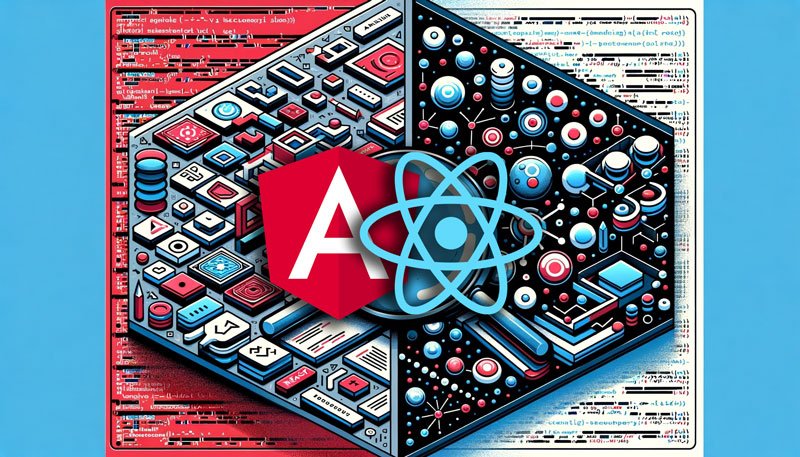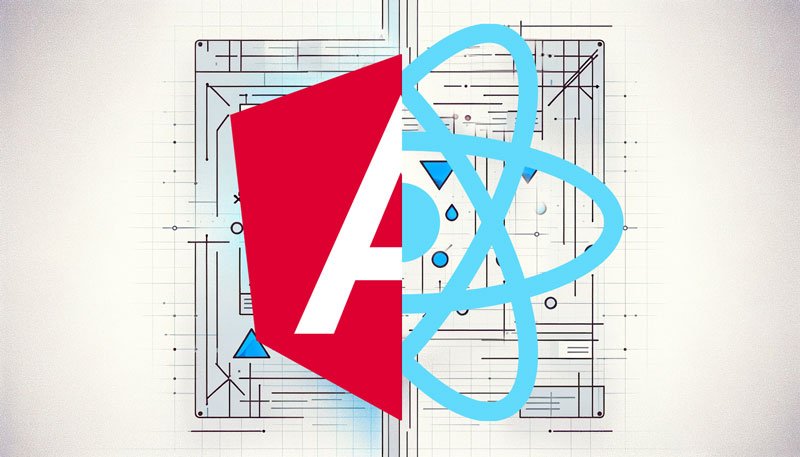Key Takeaways
- Angular and React: understanding their core differences.
- Angular’s comprehensive framework vs React’s library-based approach.
- Performance comparison: Angular’s two-way data binding vs React’s virtual DOM.
- Community support and ecosystem for Angular and React.
- Learning curve and ease of use for new developers.

In the dynamic world of web development, the debate between Angular and React for building web applications is a topic of considerable interest. Both Angular and React have their unique strengths and weaknesses, which makes them suitable for different types of projects. This article dives deep into a detailed comparison between these two front-end giants, offering insights into their core differences, performance, community support, learning curve, and more.
Angular’s Architecture: A Comprehensive Framework
Angular, developed and maintained by Google, is a comprehensive framework designed for building scalable web applications. It is a complete package, offering developers an extensive set of tools and features out of the box.
Built-in Features and Functionality
Angular’s strength lies in its rich set of built-in functionalities. It includes various features like dependency injection, routing, forms management, and more, which are essential for developing complex applications. This reduces the need for third-party libraries, ensuring a more cohesive development experience.
Two-Way Data Binding
One of the hallmark features of Angular is its two-way data binding. This feature automatically synchronizes data between the model and the view components, making it easier to handle form inputs and other user interactions. This can lead to faster and more intuitive development of dynamic applications.
TypeScript: Enhanced Code Quality and Maintainability
Angular adopts TypeScript, a superset of JavaScript, as its primary language. TypeScript introduces strong typing and object-oriented programming, leading to improved code quality, readability, and maintainability. This is particularly beneficial in large-scale projects where code management can become complex.
React: The Flexibility of a Library
React, developed by Facebook, contrasts Angular with its nature as a library rather than a full-fledged framework. This offers developers the flexibility to choose the tools and libraries they want to use alongside it.
Component-Based Architecture
React’s core is its component-based architecture, allowing developers to build encapsulated components that manage their own state. This modularity makes React highly reusable and easy to manage, especially in large applications where components can be shared and reused across different parts of the application.
The Virtual DOM: Enhanced Performance
React introduces the concept of a Virtual DOM, an abstraction of the actual DOM. When changes are made to the application’s UI, they are first reflected in the Virtual DOM. React then efficiently updates the actual DOM, leading to improved performance, especially in dynamic applications with frequent UI updates.
JSX: A Synergy of HTML and JavaScript
React uses JSX, a syntax extension that allows HTML to be written within JavaScript. This provides a more natural way to describe the UI, leading to code that is easier to understand and maintain. JSX blends the power of JavaScript with the simplicity of HTML, making it a favorite among developers who prefer a seamless integration between UI and logic.
Performance Comparison: Angular’s Two-Way Binding vs React’s Virtual DOM
When it comes to performance, both Angular and React have their advantages and drawbacks.
Angular’s Performance Considerations
Angular’s two-way data binding, while convenient, can lead to performance bottlenecks in large-scale applications. Each binding adds a watcher to the digest cycle, and a large number of watchers can slow down the application. However, Angular offers strategies like change detection strategies and Ahead-of-Time (AOT) compilation to mitigate these issues.
React’s Performance Efficiency
React’s Virtual DOM is designed for performance optimization. By minimizing direct manipulation of the actual DOM and batch updating UI changes, React ensures efficient rendering, making it particularly suitable for applications with complex interfaces and frequent updates.
Community Support and Ecosystem
Both Angular and React boast robust communities and ecosystems, playing a crucial role in the ongoing development and support of these technologies.
Angular’s Enterprise-Level Adoption
Angular’s comprehensive nature and enterprise-level features have led to its adoption by numerous large-scale applications and companies. Its community is vast, with a plethora of resources, tutorials, and third-party tools available for developers.
React’s Expansive Ecosystem
React’s popularity has surged in recent years, thanks to its flexibility and the booming ecosystem surrounding it. The React community is one of the most active in the web development world, with an abundance of libraries, tools, and extensions available to enhance its capabilities.

Learning Curve and Ease of Use
The learning curve for both Angular and React varies, depending on the developer’s background and the complexity of the project.
Angular’s Steeper Learning Curve
Due to its comprehensive nature and reliance on TypeScript, Angular often presents a steeper learning curve, especially for beginners. Its wide range of features and architectural considerations can be overwhelming for new developers.
React’s Approachable Learning Path
React, with its focus on UI development and the use of JavaScript, is generally considered more approachable, especially for those already familiar with JavaScript. Its component-based architecture and the use of JSX make it easier for new developers to start building applications quickly.
Scalability: Angular and React in Large Applications
Both Angular and React are designed with scalability in mind, but they approach it differently. This section examines how each framework/library scales in large applications.
Angular: Structured and Maintainable
Angular’s well-defined structure and framework features like dependency injection make it highly scalable. It enforces a certain architecture, which helps in maintaining consistency and manageability in large applications. This strong emphasis on structure and standards makes Angular a preferred choice for enterprise-scale projects.
React’s Modular Approach
React’s component-based architecture lends itself to scalability. Each component can be developed, tested, and maintained independently, allowing for a modular and flexible approach to scaling applications. React’s ecosystem, with tools like Redux for state management, further supports the scalability of large applications.
Ecosystem Tools and Libraries
The richness of a framework or library’s ecosystem can significantly affect development efficiency and capabilities. Here, we explore the tools and libraries available for Angular and React.
Angular’s Integrated Tools
Angular offers an integrated set of tools like Angular CLI for project generation, and Angular Material for UI components. These tools are designed to work seamlessly with Angular, providing a unified development experience.
React’s Diverse Library Support
React’s ecosystem is vast and diverse, with libraries for almost every need. From state management with Redux to routing with React Router, the community provides a wide array of tools that enhance React’s capabilities. This diversity allows developers to tailor the stack to their specific project requirements.
Testing and Debugging
Testing and debugging are crucial aspects of web development. Angular and React offer different approaches and tools for these tasks.
Angular’s Testing Frameworks
Angular is equipped with built-in testing frameworks like Jasmine and Karma, providing a robust environment for unit and end-to-end testing. Angular’s dependency injection makes it easier to mock dependencies, facilitating effective testing.
React’s Testing Flexibility
React provides more flexibility in choosing testing tools. Popular choices include Jest for unit testing and Enzyme for component testing. React’s component-based nature simplifies the process of testing individual components.
Development Experience and Productivity
The development experience and productivity are influenced by various factors, including ease of use, available tooling, and community support.
Angular: Opinionated but Consistent
Angular’s opinionated nature means developers have clear guidelines and patterns to follow, which can enhance productivity, especially in team environments. Its powerful CLI also automates many development tasks, further improving the development experience.
React: Flexible and Intuitive
React’s flexibility and the simplicity of JSX contribute to a pleasant development experience. Developers have the freedom to choose the tools and libraries that best fit their workflow, potentially increasing productivity. However, this flexibility can also lead to inconsistency, especially in larger teams.
Future Outlook and Trends
The future of Angular and React is shaped by ongoing developments, community trends, and adoption by developers and companies.
Angular’s Evolution
Angular continues to evolve, with regular updates bringing new features and improvements. Its strong backing by Google and widespread use in enterprise applications suggest a stable future for the framework.
React’s Growing Popularity
React’s popularity shows no signs of waning. Its widespread adoption, active community, and continuous improvements make it a strong contender in the web development space. React’s influence has also expanded beyond web development, notably with React Native in mobile app development.
Integration Capabilities
The ability to integrate with other tools and technologies is a key aspect of modern web development. Angular and React differ in how they integrate with external systems and technologies.
Angular: Seamless Integration with Other Tools
Angular’s design facilitates integration with a variety of tools and frameworks, making it a robust choice for complex enterprise environments. It works well with server-side technologies and has excellent support for Progressive Web Apps (PWAs).
React: Flexibility in Integration
React’s modular nature makes it highly adaptable for integration with various other libraries and frameworks. Its non-opinionated approach allows developers to choose the best tools for each project, providing the flexibility to integrate with a wide range of technologies, including server-side rendering solutions and mobile app frameworks like React Native.
Community and Resources
The size and activity level of a technology’s community can significantly impact the learning curve and problem-solving process. Both Angular and React have strong, vibrant communities.
Angular’s Global Community
Angular benefits from a large, global community. This includes extensive documentation, online courses, forums, and professional networks. Regular meetups and conferences around Angular further support community engagement and learning.
React’s Active Ecosystem
React’s community is known for its active contribution to the ecosystem. This includes a wealth of open-source projects, tutorials, and a highly active Stack Overflow community. React developers often share their knowledge and experiences, which contributes to a rich repository of learning resources.

State Management
State management is critical in web applications for maintaining user experience and data consistency. Angular and React offer different approaches to handling application state.
Angular: RxJS and Ngrx
Angular often leverages RxJS for reactive programming and Ngrx for state management, which are well-suited for handling complex application states and asynchronous data flows. This combination provides powerful tools for developers to manage state effectively in large applications.
React: Redux and Context API
React commonly uses Redux for state management, known for its simplicity and effectiveness in managing application state. Additionally, React’s Context API provides a more straightforward way to handle state without additional libraries, which is suitable for smaller applications or specific parts of larger applications.
Documentation and Learning Materials
Good documentation and learning materials are essential for mastering any technology. Angular and React both provide extensive documentation and resources for learning.
Angular Documentation
Angular’s official documentation is comprehensive, covering everything from basic concepts to advanced features. It also includes a variety of tutorials and guides to help new developers start building applications quickly.
React Documentation
React’s documentation is well-organized and beginner-friendly, with a focus on practical examples. It offers a step-by-step approach to understanding and using React, making it accessible for newcomers.
Industry Usage and Case Studies
The adoption of a technology in the industry provides insights into its practicality and robustness. Both Angular and React are used by leading companies, but often in different contexts.
Angular in Enterprise Solutions
Angular is favored in enterprise solutions due to its comprehensive nature and robust tooling. Companies like Microsoft, Autodesk, and McDonald’s use Angular for their web applications, leveraging its structured framework for complex and large-scale applications.
React’s Versatile Adoption
React’s flexibility makes it a popular choice across various industries. It’s used by companies like Facebook (its creator), Instagram, and Airbnb. React’s ability to handle dynamic content efficiently makes it a go-to choice for social media platforms, e-commerce sites, and many other interactive applications.
Migration and Upgrade Path
The ease of updating and migrating existing applications is a critical consideration for any technology stack. Angular and React have different approaches to versioning and upgrades.
Angular’s Upgrade Strategy
Angular follows a semantic versioning system, ensuring backward compatibility and smooth upgrades. The Angular team provides comprehensive upgrade guides and tools like the Angular CLI to simplify the migration process from one version to another, making it manageable for large-scale applications.
React’s Incremental Upgrades
React’s development philosophy emphasizes non-breaking changes and incremental upgrades. The React team frequently releases new features and improvements without drastically changing the core API, allowing developers to adopt new versions with minimal disruption to existing projects.
Development Costs and Time-to-Market
Development costs and time-to-market are crucial factors in project management. Angular and React influence these aspects differently due to their distinct characteristics.
Angular’s Development Overheads
Given Angular’s comprehensive nature, there might be an initial overhead in setting up and structuring the application. However, its robust set of features can reduce the need for additional libraries and tools, potentially lowering overall development costs for complex projects.
React’s Quick Prototyping
React’s simplicity and flexibility allow for rapid prototyping and faster development cycles, which can be a significant advantage for startups and projects with tight deadlines. However, the need for additional libraries for features like routing and state management might increase the project’s complexity and, consequently, its costs.

Job Market and Career Opportunities
The demand for skilled developers in Angular and React reflects their popularity in the industry. Understanding the job market for each can guide career development and hiring strategies.
Angular’s Demand in Enterprises
Angular’s widespread adoption in enterprise-level applications translates into a consistent demand for developers skilled in this framework. Angular developers are often required to have a broader skill set, including TypeScript and a solid understanding of software engineering principles.
React’s Growing Job Market
React’s popularity and growing adoption have led to a high demand for React developers. The skill set for React developers often includes modern JavaScript, state management libraries like Redux, and experience with adjacent technologies like Node.js and React Native.
Community Contributions and Open Source
The level of community contributions and open-source activity is a testament to the health and vibrancy of a technology ecosystem. Both Angular and React benefit from active community involvement.
Angular’s Open Source Contributions
Angular, being an open-source framework, has seen significant contributions from individuals and corporations alike. The community actively participates in reporting issues, contributing to the codebase, and creating third-party libraries and tools that enrich the Angular ecosystem.
React’s Thriving Open Source Culture
React’s open-source nature has fostered a thriving ecosystem. It enjoys immense support from individual developers and companies who contribute to its core codebase, develop complementary libraries, and share tools and best practices, constantly driving innovation within the React community.
Accessibility Features
Web accessibility is crucial for creating inclusive applications. Angular and React provide different levels of support for building accessible web applications.
Angular’s Accessibility Support
Angular encourages accessibility through various built-in features and best practices. It offers tools and guides to develop accessible applications, including support for ARIA attributes and keyboard navigation.
React’s Approach to Accessibility
React’s flexibility allows developers to implement accessible web applications, but it requires more manual effort compared to Angular. React’s component-based architecture can be leveraged to create reusable accessible components, and there are community-driven libraries available to assist in this process.
Code Reusability and Component Sharing
Code reusability is a critical factor for efficient development. Angular and React handle component sharing and reusability in distinct ways.
Angular’s Modular Architecture
Angular’s modular architecture promotes reusability through its dependency injection system. It allows developers to create reusable services, components, and modules, which can be easily shared across different parts of the application or even across different projects.
React’s Reusable Components
React’s strength lies in its component-based structure. Components in React are highly reusable and can be seamlessly integrated across various parts of an application. This modularity not only enhances development speed but also improves code maintainability.
Security Features and Considerations
Security is paramount in web development. Angular and React offer different levels of security features and considerations.
Angular’s Built-in Security Measures
Angular provides built-in protections against common web vulnerabilities like cross-site scripting (XSS) and cross-site request forgery (CSRF). Its template binding syntax automatically handles escaping of untrusted values, making applications more secure by default.
React’s Security Practices
React follows a secure-by-default approach, escaping all rendered values to protect against XSS attacks. However, developers need to be mindful of security when using React, especially when integrating with other libraries or when handling user-generated content.
Mobile Development Capabilities
The ability to adapt web applications for mobile platforms is increasingly important. Angular and React cater to mobile development in different ways.
Angular for Mobile Apps
Angular can be used for mobile app development when combined with frameworks like Ionic or NativeScript. This allows for the creation of hybrid mobile applications that can leverage Angular’s robust features and tooling.
React Native: A Game Changer
React’s mobile development capabilities are significantly enhanced by React Native, a framework for building native mobile apps using React. React Native enables developers to create high-performance mobile applications for iOS and Android using a single codebase.
Localization and Internationalization
Creating applications that cater to a global audience requires effective localization and internationalization strategies. Angular and React provide tools and frameworks to support these needs.
Angular’s i18n Support
Angular has comprehensive support for internationalization (i18n), allowing developers to create applications that support multiple languages and regional settings. Angular’s i18n tools enable seamless translation of content and adaptation to various locales.
React’s Flexible Internationalization
React does not have built-in internationalization support but can be easily integrated with libraries like React Intl or i18next. This flexibility allows developers to implement custom solutions tailored to the specific requirements of their applications.
Real-World Applications and Success Stories
Examining real-world applications and success stories can provide valuable insights into the practicality and effectiveness of Angular and React.
Angular’s Enterprise Successes
Angular has been successfully used in enterprise-level applications, with companies like Delta Airlines, Upwork, and Forbes leveraging its comprehensive framework to build robust and scalable web applications.
React’s Diverse Portfolio
React has a diverse portfolio of successful applications, including Facebook (its creator), Instagram, and WhatsApp. Its flexibility and performance have made it a popular choice for a wide range of web applications, from social media platforms to e-commerce sites.
Performance Optimization Strategies
Performance is a key consideration for any web application. Angular and React offer different strategies for optimizing performance.
Angular’s Performance Tactics
Angular provides various optimization techniques like lazy loading, server-side rendering with Angular Universal, and Ahead-of-Time (AOT) compilation. These methods help in reducing the load time and improving the runtime performance of applications.
React’s Optimization Approaches
React’s performance can be optimized using techniques such as code splitting, lazy loading with React.lazy and Suspense, and memoization. React also benefits from the efficient update and rendering mechanism provided by its virtual DOM.
Deployment and Hosting
The ease of deployment and hosting options can influence the choice between Angular and React for a project.
Angular Deployment
Angular applications can be easily deployed to various hosting platforms, including traditional web servers and cloud-based hosting services like AWS, Firebase, and Netlify. Angular’s build process generates a set of static files, simplifying the deployment process.
React Hosting Flexibility
React applications, similar to Angular, can be hosted on a wide range of hosting services. The deployment process is straightforward as React also produces a set of static files that can be served from any web server or hosting platform.
Developer Tools and IDE Support
Effective development tools and IDE (Integrated Development Environment) support can significantly enhance productivity.
Angular’s IDE Integration
Angular is well-supported by major IDEs like Visual Studio Code, WebStorm, and others. These IDEs provide powerful features like intelligent code completion, error detection, and refactoring tools specifically tailored for Angular development.
React’s Tooling Ecosystem
React’s developer tooling includes React Developer Tools, a browser extension that provides deep insights into React component trees. IDEs like Visual Studio Code and Sublime Text offer extensive support for React, including syntax highlighting, snippets, and advanced debugging capabilities.

Browser Compatibility and Polyfills
Compatibility with various browsers is crucial for the reach and user experience of web applications.
Angular and Browser Support
Angular applications are compatible with most modern browsers. For older browsers, Angular provides polyfills to ensure compatibility, though this might require additional setup and testing.
React’s Cross-Browser Functionality
React supports all modern browsers. Similar to Angular, React can be made compatible with older browsers using polyfills, ensuring that applications function correctly across a wide range of browser environments.
Future-Proofing and Long-Term Viability
Considering the future-proofing and long-term viability of a technology is essential for sustainable development.
Angular’s Continued Evolution
Angular is committed to regular updates and long-term support, as evidenced by its versioning and upgrade policies. This commitment, backed by Google, suggests a strong future for Angular in the web development landscape.
React’s Sustained Growth
React’s popularity and adoption show no signs of slowing down. Its community-driven development, constant enhancements, and Facebook’s backing indicate that React will remain a key player in the future of web development.
Table: Angular vs. React – A Comparative Overview
| Feature | Angular | React |
|---|---|---|
| Nature | Full-fledged framework | Library |
| Core Philosophy | Comprehensive solution, opinionated | Flexible, component-based |
| Language | TypeScript | JavaScript (ES6+), JSX |
| Performance | Two-way data binding, AOT Compilation | Virtual DOM, efficient updates |
| Learning Curve | Steeper, more concepts to grasp | Relatively gentle, especially with JavaScript knowledge |
| Ecosystem | Rich, integrated tools and libraries | Extensive, diverse libraries |
| Community Support | Large, global community, enterprise-focused | Highly active, open-source contributions |
| Mobile Development | Possible with Ionic/NativeScript | React Native for native apps |
| Testing | Built-in testing frameworks like Jasmine and Karma | Flexibility in choosing tools (Jest, Enzyme) |
| Scalability | Well-suited for large, complex applications | Scales well with component-based architecture |
| Browser Compatibility | Modern browsers, polyfills for older ones | Modern browsers, polyfills for older ones |
| Ideal Use Case | Enterprise-level applications | Dynamic web applications, UI-focused projects |
Conclusion
Angular and React both stand as powerful contenders in the world of web development, each bringing unique strengths to the table. Angular offers a more structured environment, which can be particularly advantageous for developing large-scale enterprise applications. Its comprehensive nature and robust set of features make it a go-to choice for projects that require a full-fledged framework. On the other hand, React provides developers with the flexibility to build dynamic user interfaces with a component-based approach. Its simplicity and compatibility with a wide range of libraries make it ideal for developers seeking a more agile development process.
Ultimately, the choice between Angular and React depends on the specific requirements of the project, the team’s expertise, and the desired scalability. Both technologies continue to evolve, adding new features and enhancements, and maintaining strong community support. By understanding the key differences and strengths of each, developers and organizations can make informed decisions that best suit their project needs.
Frequently Asked Questions
What are the primary differences between Angular and React?
Angular is a comprehensive framework offering a complete solution for building web applications, while React is a library focused on building user interfaces. Angular uses TypeScript, and React uses JSX and JavaScript.
Is Angular or React better for beginners?
React tends to have a gentler learning curve for beginners, especially those already familiar with JavaScript. Angular, while powerful, can be more challenging to learn due to its comprehensive nature and TypeScript.
Can React and Angular be used for mobile app development?
Yes, Angular can be used with frameworks like Ionic or NativeScript for mobile app development. React has React Native, a separate framework for building native mobile apps.
How do Angular and React handle state management?
Angular uses RxJS and Ngrx for sophisticated state management, suitable for complex applications. React uses Redux and the Context API for more straightforward state management needs.
Are Angular and React suitable for large-scale applications?
Both Angular and React are suitable for large-scale applications. Angular’s structure and features lend themselves well to enterprise-level projects, while React’s component-based architecture allows it to scale effectively for large applications.
How often do Angular and React get updated?
Both Angular and React have regular update cycles. Angular follows semantic versioning with scheduled major releases, while React updates focus on non-breaking, incremental improvements.
Which is more popular, Angular or React?
React generally has a larger community and is more popular in the developer community, particularly for its flexibility and ease of use. Angular has a strong presence in enterprise-level applications.
Can I switch from Angular to React or vice versa?
Yes, developers can switch between Angular and React, but it requires learning the different paradigms and concepts inherent in each. Familiarity with JavaScript and modern web development practices is beneficial in transitioning between the two.